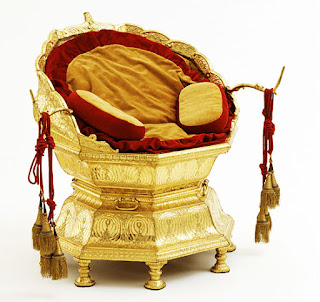 |
| Punjab province. Maharajah Ranjit Singh's throne vam.ac.uk |
Above image: Maharajah Ranjit Singh's throne made by the goldsmith Hafez Muhammad Multani about 1820 to 1830, for the Sikh empire, has a wood and resin core, covered with sheets of repoussé, chased and engraved gold.
fabulously rich, his court was richly embellished and decorated with richly worked sheets of gold. The gold throne is a sturdy one with cusped base, and has has two tiers of lotus petals, lotus being a symbol of purity and creation. Lotus throne has traditionally been used as a seat or throne for Hindu god. A man of simplicity he preferred to sit with crossed-legs on the carpet instead on the throne.
East India company using the Doctrine of lapse as an excuse annexed the kingdom after the Second Anglo-Sikh War and took away the gold throne, a State Property. The wily British took advantage of a chaotic political situation after the death of ruler Ranjit Singh. However, Duleep Singh, a young prince was made a legal heir. The English company not only made Punjab a part of the British empire, but also took away the palace treasures to London
The treasures plundered by the English company from Punjab were at the Great Exhibition in 1851. Later they were shifted to India Museum, London. Presently at the Victoria & Albert Museum, the British government refused to return the gold throne to Punjab, as it was the legacy of the last ruler of untied Punjab. The other treasures included the famous Koh-i-noor diamond and the Timur ruby.
Tit-bits:
Maharajah Ranjit Singh:
 |
| Maharajah Ranjit singh of Punjab province. sikhnet.com |
Maharajah Ranjit Singh (2 November 1780 – 27 June 1839) often referred to as Sher-e-Punjab or "Lion of Punjab", took the credit of being the first Maharaja of the Sikh Empire, which ruled the northwest Indian subcontinent in the early half of the 19th century. He survived smallpox in infancy but Though he lost sight in his left eye due to smallpox when he was a child, he was a courageous warrior and a man of exceptional talents. Brought up as a warrior as young kid, when he was just 10 years old he fought his first battle alongside his father at age. Upon his father's death he had to confront several wars to expel Afghans in his late teens was proclaimed as the "Maharajah of Punjab" at age 21. Through shher hardwork and victory in battles, he gradually expanded his kingdom till 1839.
prior to his rise as strong leader and ruler, Punjab was rife with many warring groups with no unity among them. The 12 confederacies (11 under Sikh ruler; one under a Muslim ruler) came under the leadership of Ranjit Singh and the ruler successfully absorbed and united the Sikh misls and took over other local kingdoms to create the Sikh Empire. This consolidation of all rulers under one roof helped him a lot and he successfully tackled the frequent invasions from other places , particularly those from Afghanistan; his military alliance with the English company was an added advantage. In his government lots of Europeans, Muslims and other people worked and during his heyday Punjab saw cultural renaissance. He treated all with same respect and with magnanimity. In 1835, Maharaja Ranjit Singh donated 1 ton of gold for plating the Kashi Vishwanath Temple's dome. He also helped Muslims when they built the mosques in his region. He died in 1839 at the age of 58.
http://www.vam.ac.uk/content/articles/t/the-court-of-maharaja-ranjit-singh/
https://en.wikipedia.org/wiki/Ranjit_Singh









